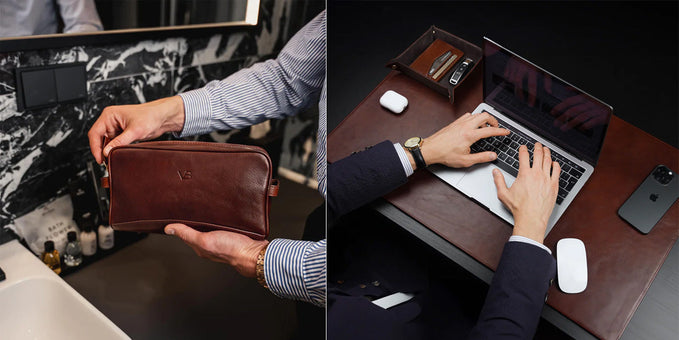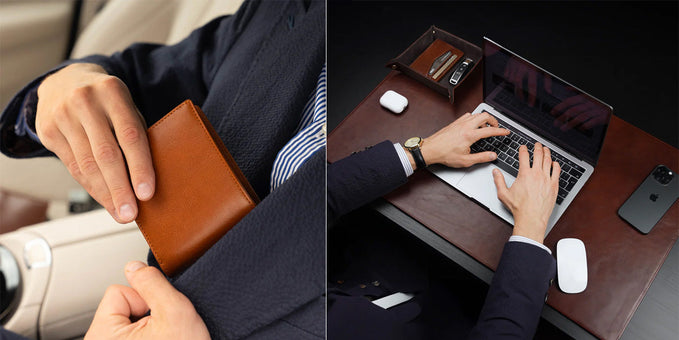Genuine Leather

Seeing “Genuine Leather” on a briefcase or a pair of shoes seems fantastic while browsing the stores. Right?
Doesn’t that sound like you’re receiving the genuine article?
Sorry to disappoint you, but it’s not as great as it seems.
The term “genuine leather” just indicates that the fabric contains some leather; it does not imply magnificent leather.
In this post, we’ll examine the production process for real leather, compare it to other forms of leather, and discuss how to maintain your genuine leather goods.
What Exactly Is Genuine Leather and What Is It Made Of?
When you buy genuine leather, you are not purchasing fake leather; rather, you are purchasing inferior leather. Essentially, it merely indicates that the grain is not top or full-grain. It could mean a variety of things. It is unclear on purpose.
Split leather is frequently mistaken for genuine leather. It describes the removal of the hide’s lower (inner) layers. “Top grain” refers to the exterior, higher-quality components.
The thickness of the skin determines whether it is possible to remove many layers from a single hide. Certain skins, like cow skins, can frequently be divided into different tiers. Genuine leather can be found in the layers between suede and top grain. It refers to the location in the hide, not the quality.
Genuine leather may occasionally be combined with leather scraps, synthetic materials, and bonding chemicals.
Appearance
If you’re not worried about creating a product with the durability of premium leather, you might be able to trick some customers into thinking your genuine leather product is real.
Genuine leather can have a wide range of aesthetics because it just signifies that leather is present in the product. In some regions, even the poorest rung of leather goods - such as bi-cast and bonded leather - can be considered “genuine.”
So, this category of leather doesn’t have a uniform appearance. Yet as it wears down quickly, its inferiority will become apparent.
Quality
At least, genuine leather is leather. It’s near the bottom of the list of potential grains and cuts, though. It’s unquestionably a lower-grade item when compared to leathers of higher quality, like full-grain and top-grain.
“Genuine leather” does not hold up as well over time as finer leather goods. It might make an excellent first impression, but it won’t hold up to constant use.
Full-grain leather is far better, which is why we use it on our bags at Von Baer.
Products Genuine Leather Is Frequently Used For
Genuine leather can be found in various products because it is almost a catch-all term for everything that is not a better grade. It may be used to create various products, including handbags, briefcases, shoes, and purses.
All the same, this variety of products’ inferior quality unites them. These aren’t things you’d find in upscale shops. Instead, these will be found in department stores, mall kiosks, and the more affordable shoes in the shoe section.
Related:
- Leather
- Faux leather
- Vegan leather
- Faux leather vs real leather
- Bonded leather
- Pleather
- Top grain leather
- Leather types
- Leather guide for beginners
- What is leather patina
- Vegetable tanned leather
- Leather tanning
- What is artificial leather?
- What is full grain leather
Benefits of Genuine vs Others
The main benefits of choosing genuine leather are the cost and the way it feels and looks. Genuine leather is an appropriate substitute if you cannot invest in a high-end leather item or do not choose to do so but still desire the “appearance.”
It’s also easy to keep up with. Even though it won’t live for very long, you can assist in prolonging its life and appearance by giving it some simple care. If taken care of properly, it will continue to function for years.
Downsides
Genuine leather is not necessarily nice leather, as we have made clear. It often develops stretch marks over time. Even though it initially has a good appearance, it will soon start to deteriorate.
This leather could make you feel a little hot and sweaty during warmer temperatures.
Only individuals who haven’t read this article can be affected by another potential drawback of this kind of leather. Because of the false name of this product, dishonest sellers may occasionally overcharge for it.
This leather might be misrepresented to uninformed, ignorant consumers as better leather.
Caring Instructions
Genuine leather requires only a quick wipe-down with a moist cloth for maintenance and cleaning. If you’re in a dry, dusty environment, you can carry out this task on a frequent basis or perhaps every day. Just make certain that the fabric is damp, not wet.
Another step you may take to maintain your genuine leather products is polishing. There are moisturizing components in many polishes. Compare prices and read reviews to determine which options are the best.
On genuine leather products, a conditioner or cream can be used. It prevents them from drying out or cracking. The things will get protected but won’t shine.
Related:
- Repair cat scratches on leather
- Remove water stains from leather
- Clean leather wallet & remove stains/smells
- Remove ink from leather
- Get smell out of leather
- Remove stains from leather shoes
- Clean suede leather bag
- How to reform a leather bag
- How to maintain leather bags
- Repair cracked leather
- Wet leather
- How to clean leather bag
- How to restore faded leather bag
- Suede
- PU leather
- Bonded leather vs Faux leather
Cost vs. Quality: Real Leather or Full-Grain Leather?
This typical problem often arises while purchasing leather. Get a higher-grade leather for a steeper price, or take a chance on a lesser-quality leather for a less high and more affordable price.
The temptation to purchase something less expensive and more accessible is always present, especially when leather appears high-end. But sacrificing quality for money is not always the greatest choice.
Spending a lot of money on leather is not always a good idea. Strongness and durability are excellent selling features, but high prices frequently turn away potential customers.
At some point, you’ll ask yourself, “Is it worth it?”
At Vonbaer.com, we recognize that it's better to buy a quality product as an investment than buy cheap and buy twice. That's why we only stock full-grain leather bags.
How to Identify Genuine Leather in a Product
Understanding the type of leather you're buying can help you tell low-quality leather from high-quality leather.
Related articles:
- Where does leather come from
- Mushroom leather
- Napa leather
- Pebbled leather
- Leather grades
- How is leather made
- Italian leather
- How to tell if leather is real
- Buffalo leather
- Suede vs Leather
- What is Real Leather
- Pu Leather vs Faux Leather
- Alternative Leather
- Chrome Tan Leather
Labelling
Genuine leather often looks the same as other types of leather at the start, so understanding labeling is your best defense.
You’re better avoiding any product that doesn’t explicitly state the type of leather
Genuine leather is typically identified as “made from” or “made using” leather on the label. Products with these labels often originate from genuine leather, not faux leather.
Choose a product that explicitly says the type of leather, eg "full grain leather".
Smell
Avoiding fake leather may seem difficult. But you will notice the bad smell if you smell the faux leather. If it has a chemical or plastic-like odor, it’s probably faux leather. Genuine leather typically smells musty.
Edge
You can distinguish between genuine leather and imitation leather by using your senses of touch and sight. Most of the time, natural leather has rough edges, yet this is not always the case. Often, fake leather has perfectly straight edges.
Bend the Leather
The strength and durability of the leather can be tested by bending it. But it also indicates if the leather is genuine or faux. Real leather’s color will somewhat alter with a slight bent. Nothing will change with fake leather.
Moisture
Dropping a small amount of water also helps, but we’re not sure if you can do this in stores. While synthetic leather typically rolls off moisture, real leather is designed to absorb it. Because dampness can damage the leather, we are not advising you to do this. This is just a little hint or trick.
The Fire Test
Although we are very certain that you cannot do this in a store, you might be able to if you are at home. Make sure you test your leather on the bottom or a difficult-to-see region because the fire test will probably ruin a significant portion of it. Just expose the leather to a flame for three to five seconds.
Real leather is present even if there is only a tiny scorch.
Moreover, you’ll detect a stench of scorched hair. If the leather ignites and burns (oops), it is faux leather. It smells like burning plastic because it is composed of polyurethane, so that should be expected.
The Price
Hardly ever is real leather affordable. And the price is high for a reason. Even genuine leather of poorer quality is nonetheless worth more than fake leather. This is not final! Beware of con artists. It’s crucial to heed other advice we’ve provided.
Conclusion
We hope you enjoyed our article on Genuine leather.
If you have any questions, leave them in the comments or email Von Baer at info@vonbaer.com.
Browse related leather pages here.

Author: Albert Varkki
Albert Varkki is the co-founder of Von Baer. He understands leather products as a consumer, supplier, and a manufacturer, helping you with the inside knowledge you need, to choose the perfect leather product for you.
We strive for the highest editorial standards, and to only publish accurate information on our website.
Leave a Comment
Your email address will not be published.






